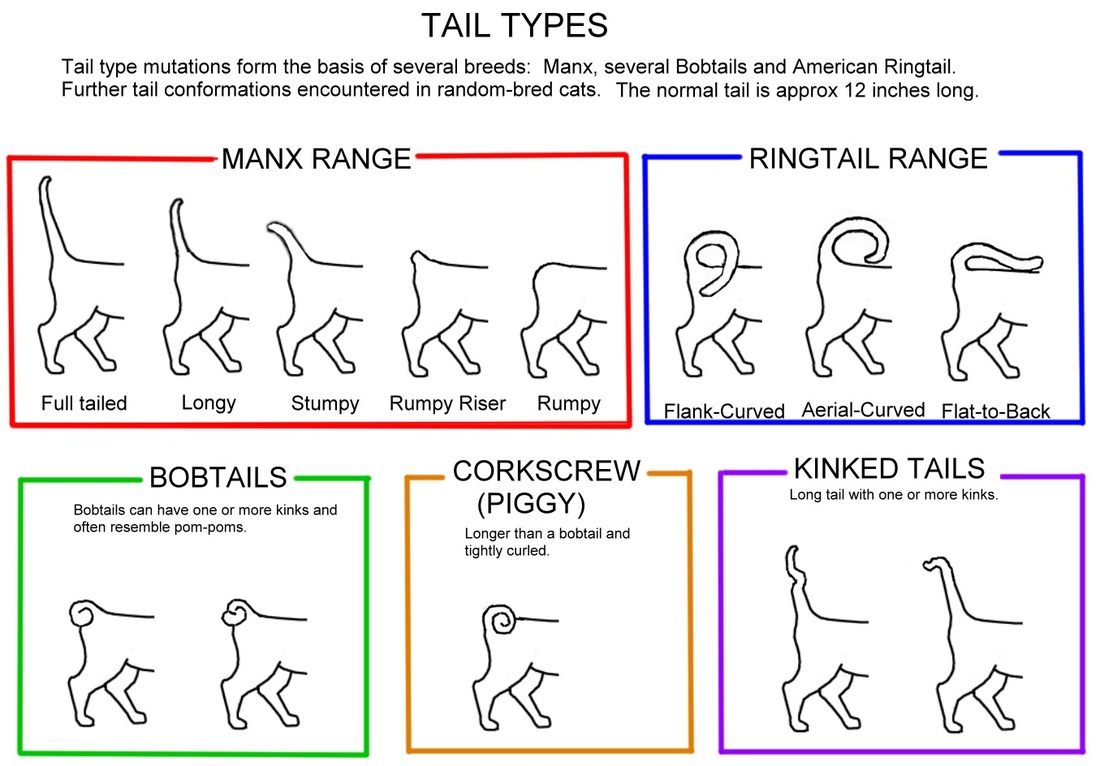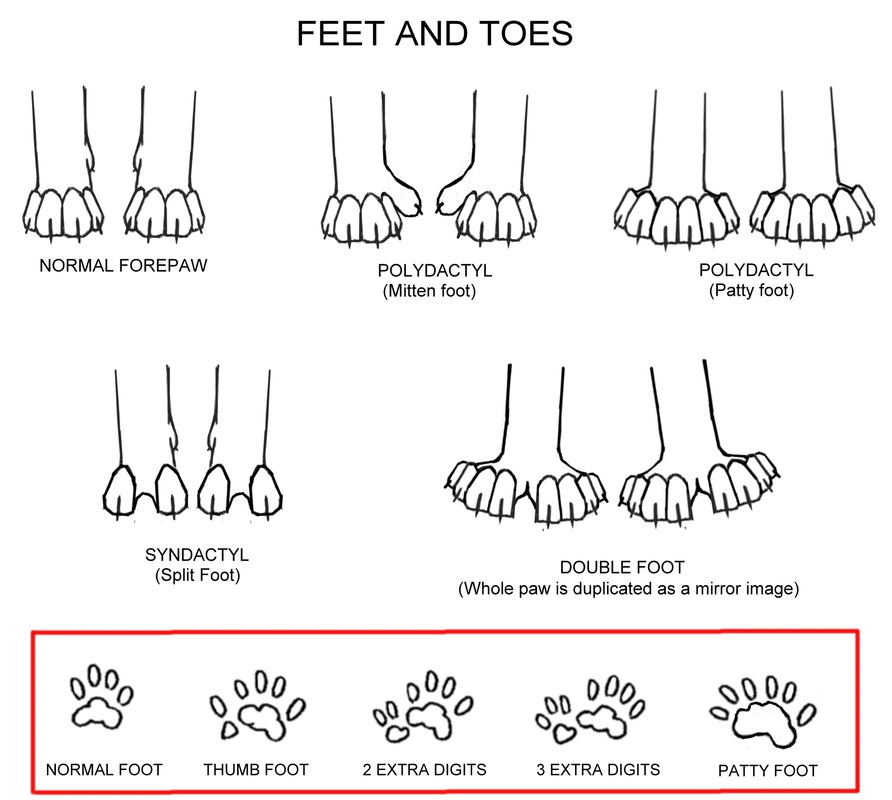Breed Mutations
The following are descriptions of the various mutations that a kitten/cat may have. They are not always born with all of them and there is no way to control this.
Bobtails
The following is an explanation of the varying tail lengths that you will see among American Highland Lynx/Highlander tails:
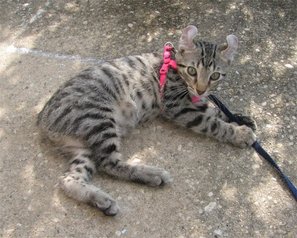
Rumpy: No tail. A dimple may be present or a ball of cartilage. Occasionally a Rumpy may have difficulty going to the bathroom at times as a kitten. They usually grow out of this, but occasionally do not.
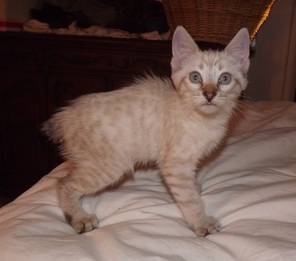
Rumpy Riser: A short knob tail with 1-3 vertebrae that are covered with tufts of
fur.
fur.
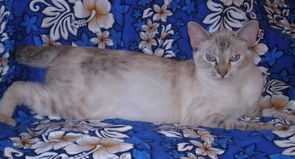
Stumpy/Natural short: This short tail has a couple of caudal vertebrae that may
be curved or kinked. Usually about 2-3 ½ inches long.
be curved or kinked. Usually about 2-3 ½ inches long.

Hock Length: A tail that goes to the pointy part (hock) of the leg.
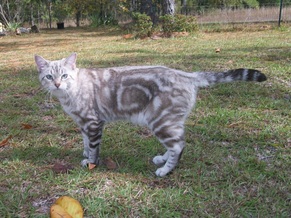
¾ tail: A tail that goes past the hock of the leg.
Polydactyl Feet
Most cats have four toes and one dewclaw (thumb) on each front paw and four toes on each hind paw. Polydactyl cats may have as many as seven digits on front and/or hind paws, and various combinations of anywhere from four to seven are common. Polydactyl feet are most commonly found on the front paws only but, polydactyl can occur on all four paws and this is called 4x4. It is rare for a cat to have polydactyl hind paws only. American Exotic Cats strives to have 4x4 polydactyl feet, but not all cats bred here will have them. TICA Highlanders are not supposed to have polydactyl feet. Special care must be taken as there may be tiny nails in between the toes that need trimming or hanging nails with no pads.
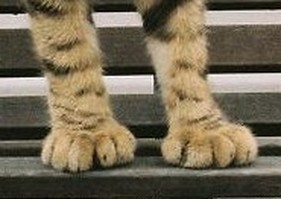
Patty feet
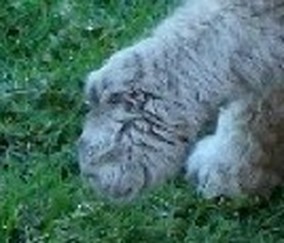
Mitten feet
Curled Ears
This mutation is a dominant gene so litters will often contain a mix of curl-eared and prick-eared cats. It is impossible to tell which kittens will develop a good curl - they are all born prick eared. The ears curl up tightly over the next few days. During the next four months, the tight curl starts to relax until the final semi-curled state is reached. The Highland Lynx was created using a Hemingway Curl. The Hemingway Curl is a localized variety rather than a breed. The first Hemingway Curl appeared as a spontaneous curl-eared mutation in a colony of polydactyl cats known as Hemingway cats (after the polydactyl cats of Ernest Hemingway) on Key West. Hemingway Curls have since been crossed with African Jungle cat hybrids to produce the Jungle Curl breed. (http://www.messybeast.com/foldear-cats.html)
Because of the curled ear mutation, ears need to be checked regularly as part of their grooming routine. A problem can exist when the ear canal twists and becomes narrowed, which can cause problems by not being able to clean the ear wax and continuous ear infections.The curling of the ear can cause irritation where the hair follows the curve of the curl increasing the production of ear wax. The outer area of the ear should be gently swabbed with q-tips. It is important not to swab deeply into the ear as you may only push wax against the ear drum, causing pain and an eventual ear infection.
Because of the curled ear mutation, ears need to be checked regularly as part of their grooming routine. A problem can exist when the ear canal twists and becomes narrowed, which can cause problems by not being able to clean the ear wax and continuous ear infections.The curling of the ear can cause irritation where the hair follows the curve of the curl increasing the production of ear wax. The outer area of the ear should be gently swabbed with q-tips. It is important not to swab deeply into the ear as you may only push wax against the ear drum, causing pain and an eventual ear infection.
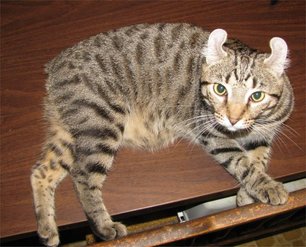
Loose Curled ears
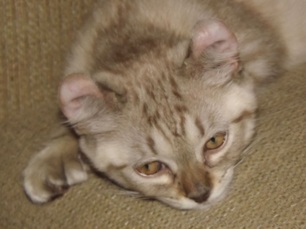
Tight Curled ears
